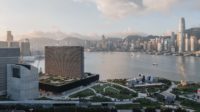One of the world’s most ambitious civic projects, the West Kowloon Cultural District in Hong Kong gained momentum today. The District announced that Herzog & de Meuron, in partnership with TFP Farrells, won the job to design Hong Kong’s largest contemporary art museum called M+.
Herzog & de Meuron and TFP Farrells beat out five other teams: Renzo Piano Building Workshop; Kazuyo Sejima and Ryue Nishizwas/SANAA; Toyo Ito & Associates and Benoy; Shigeru Ban Architects and Thomas Chow Architects; and Snøhetta.
The M+ project, slated for completion in 2017, will join several other proposed cultural venues, including the Xiqu Centre designed by Bing Thom, as part of the District’s first, multi-billion dollar development phase. M+ will rest on the waterfront of Victoria Harbor at the edge of a lush, 100-acre park and within a master plan devised by Foster + Partners.
The museum’s collection will encompass contemporary visual culture from Hong Kong, China, and beyond.
“It will become the most important platform for contemporary art in Asia,” says senior partner Jacques Herzog, “so we have to give the local community of artists a venue that is theirs.” Herzog and his partner Pierre de Meuron won the Pritzker Prize in 2001.
Rather than imitate Chinese architecture, Herzog said the architects designed the building to reflect the Chinese principles of opposites—darkness and light.
Two perpendicular elements of steel and glass will compose the 645,000-square-foot structure. The horizontal slab will function as a gallery space and the vertical one—echoing Kowloon’s skyline—will contain office and administrative spaces.
The design activates existing infrastructure, connecting the museum to Hong Kong’s Airport Express via a tunnel. A raw, underground space will serve as a site for display and performance, “as opposed to white cube galleries,” Herzog explains. At night, LED lights will project art onto the building’s vertical element like a billboard.
Herzog says, “The greatest challenge for architects is to do buildings that generate public life and creative life and make the city more itself.”










Post a comment to this article
Report Abusive Comment